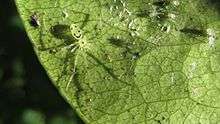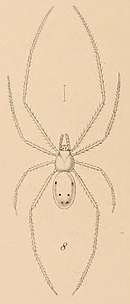Theridion grallator
Theridion grallator, also known as the Hawaiian happy-face spider, is a spider in the family Theridiidae. Its Hawaiian name is nananana makakiʻi (face-patterned spider)[2]. The specific epithet grallator is Latin for "stilt walker", a reference to the species' long, spindly legs.
| Theridion grallator | |
|---|---|
 | |
| Scientific classification | |
| Kingdom: | Animalia |
| Phylum: | Arthropoda |
| Subphylum: | Chelicerata |
| Class: | Arachnida |
| Order: | Araneae |
| Infraorder: | Araneomorphae |
| Family: | Theridiidae |
| Genus: | Theridion |
| Species: | T. grallator |
| Binomial name | |
| Theridion grallator | |
Appearance

The spider is up to 5 millimetres (0.20 in) long.[3] Certain morphs have a pattern resembling a smiley face or a grinning clown face on their yellow body. Each spider has a unique pattern, and the patterns differ from island to island. Some lack markings altogether.[3]
On the island of Maui, the happy types seem to follow simple Mendelian inheritance rules, while on other Hawaiian islands the body inheritance patterns seem to be sex-limited.[4] The variation is possibly a kind of camouflage against birds, their only natural enemies of significance, to counteract pattern recognition by predators. As the background color may change according to what food the spider has eaten[5] and as T. grallator is small, hides during the day, and is not a significant prey item for any species of predator, it is possible that the large variety of patterns serves no significant adaptive purpose.
Ecology
T. grallator lives beneath the leaves of plants, where they spin a much reduced web.[5] Instead of using the web as a prey-detection medium, it has been demonstrated that vibrations of prey transmitted through the residence leaf are detected by the spiders and guides their orientation toward potential prey. Mature males actively move through forest vegetation seeking out females which are more sedentary. A courtship dance involving somatic movements and web-plucking on the part of the male is assessed by potential female mates. Copulation occurs at night, while both spiders hang from the underside of the leaf. Males die soon after mating, but females live longer, and guard their eggs until they hatch, and catch prey for their young. T. grallator hunts mainly from dusk, through the evening, to dawn. By day, the spiders assume a remarkable posture that flattens the body against the residence leaf, with legs splayed out and all joints held flat against the leaf.
Distribution
.png)
T. grallator is endemic to the Hawaiian archipelago, and have been reported from Oʻahu, Molokaʻi, Maui and the island of Hawaiʻi in rainforests at elevations of 300–2,000 m (980–6,560 ft).
Evolution
The closest relatives of T. grallator are other Hawaiian species, such as T. posticatum and T. kauaiense. This "T. grallator clade" may be more closely related to the genus Exalbidion than to any other species currently classified in the genus Theridion.[6]
References
- "Taxon details Theridion grallator Simon, 1900", World Spider Catalog, Natural History Museum Bern, retrieved 2016-01-30
- Hawaiian Dictionaries
- Rosemary G. Gillespie & Bruce E. Tabashink (1989). "What makes a happy face? Determinants of colour pattern in the Hawaiian happy face spider Theridion grallator (Araneae, Theridiidae)". Heredity. 62 (3): 355–363. doi:10.1038/hdy.1989.50.
- http://www.benecke.com/happyface.html
- Rosemary G. Gillespie (1989). "Diet-induced color change in the Hawaiian happy-face spider Theridion grallator (Araneae, Theridiidae)" (PDF). Journal of Arachnology. 17 (2): 171–177.
- Miquel A. Arnedo, Ingi Agnarsson & Rosemary G. Gillespie (2007). "Molecular insights into the phylogenetic structure of the spider genus Theridion (Araneae, Theridiidae) and the origin of the Hawaiian Theridion-like fauna" (PDF). Zoologica Scripta. 36 (4): 337–352. doi:10.1111/j.1463-6409.2007.00280.x.